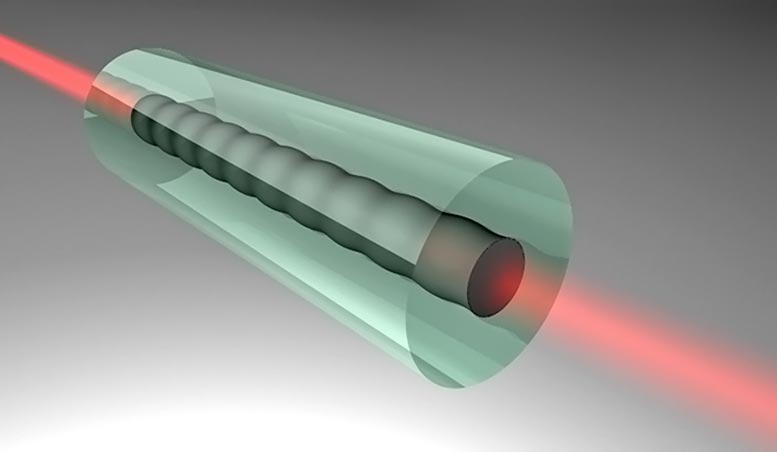
Laser light generates and probes sound waves in the core of a fiber optic waveguide.
A newly published study from Yale scientists reveals how to enhance the lifetime of sound waves traveling through glass — the material at the heart of fiber optic technologies.
Everyday experience tells us that glass (silica) is highly transparent. In fact, silica is one of the most transparent materials on earth. Light can propagate for tens of kilometers in silica before it experiences any appreciable weakening. This transparency, combined with glass’ formability and low cost, is why glass is used in so many of the fiber-optic technologies that shape the information age.
Yet silica also has a mysterious side. At room temperature, silica is an excellent acoustic material. You can demonstrate this by tapping a wine glass with a fork and listening to it ring for several seconds. However, in sharp contrast with most materials, this resonance is quickly muted when the glass is cooled to cryogenic temperatures.
These peculiar acoustic properties are at the heart of long-standing mysteries in glass physics. In the 1960s scientists discovered many perplexing properties of glass: It conducted heat much less efficiently than expected, and it heated up much more slowly than anticipated. These puzzling discoveries were ultimately explained by localized absorbers within glass that interact with sound waves in the same manner that atoms interact with light. To this day however, the true nature of these “acoustic atoms” is not fully understood.
In addition, absorption by these “acoustic atoms” has another consequence that intrigues scientists. At low temperatures, the amplitude of a sound wave affects how long it will ring. Roughly speaking, this means you can make your wine glass ring longer by turning on your stereo, which causes the glass to vibrate at altogether different frequencies. Moreover, the duration of the ringing increases as the stereo volume is turned up.
Yale scientists have used this concept to control the lifetime of sound within glass. By shining laser light into fiber optic waveguides made of glass, they were able to probe and generate acoustic waves in the fiber core. By generating an intense acoustic wave at one frequency (i.e. “turning on the stereo”) and probing at another (“tapping a wine glass”), the researchers were able to extend the lifetime of a sound wave.
The researchers said that because glass is the backbone of a range of cutting-edge technologies, the findings open the possibility of new forms of high-precision sensing and information processing.
“Our work takes an important step toward engineered sound dynamics in glass,” said Peter Rakich, assistant professor of applied physics and physics at Yale and principal investigator of the study.
First author Ryan Behunin, an associate research scientist in Rakich’s lab, said, “Our results demonstrate a new paradigm for achieving higher performance in optomechanical systems.”
The discovery is described in the January edition of the journal Nature Materials.
Co-authors of the study were Yale graduate student Prashanta Kharel and associate research scientist William Renninger.
Reference: “Engineering dissipation with phononic spectral hole burning” by R. O. Behunin, P. Kharel, W. H. Renninger and P. T. Rakich, 12 December 2016, Nature Materials.
DOI: 10.1038/nmat4819








While the newly published paper examines a single component electrolyte, aluminum oxide by itself, Nakanishi says “our aim is to extend this approach so that we can measure chemical potentials, Gibbs energy, in multi-component electrolytes.”